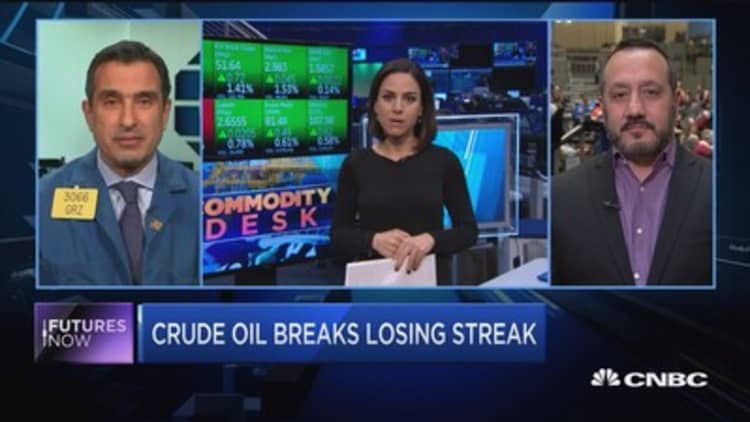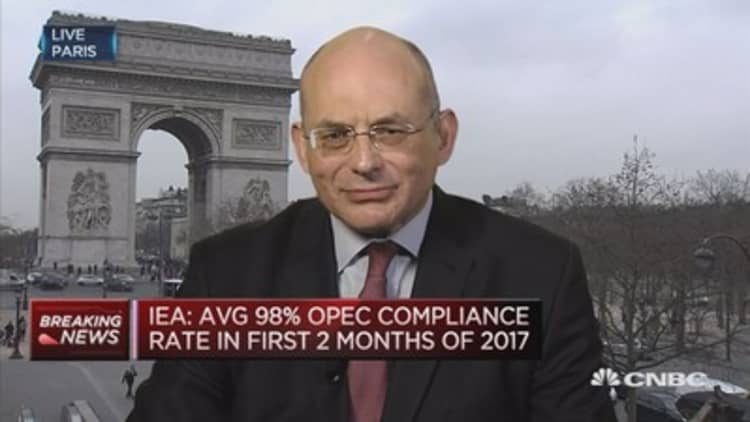
Oil prices rose more than 2 percent Wednesday, lifted by a surprise drawdown in U.S. crude inventories and data from the International Energy Agency (IEA) suggesting OPEC cuts should create a crude deficit in the first half of 2017.
Data from the U.S. Energy Information Administration (EIA) showed U.S. crude stocks fell last week, dropping after nine consecutive increases.
Inventories fell by 237,000 barrels in the week to March 10, compared with analysts' expectations for an increase of 3.7 million barrels.
The IEA said global inventories rose in January for the first time in six months despite OPEC output cuts, but said if it stuck to its production curbs the market should see a deficit of 500,000 barrels per day (bpd) in the first half.
"For those looking for a rebalancing of the oil market the message is that they should be patient, and hold their nerve," the IEA said in its monthly report.

U.S. West Texas Intermediate crude ended Wednesday's trade up $1.14, or 2.4 percent, at $48.86, snapping a seven-session losing streak.
Brent futures were up 83 cents, or 1.6 percent, at $51.75 a barrel by 2:39 p.m. ET (1839 GMT). Prices had hit a three-month low of $50.25 during the previous day's trading.
Prices extended gains after the U.S. Federal Reserve raised interest rates in a widely anticipated move that sent the dollar index lower. A weaker greenback makes dollar-denominated crude oil more affordable to holders of other currencies.
EIA also reported gasoline stocks fell by 3.1 million barrels, compared with analysts' expectations in a Reuters poll for a 2 million-barrel drop. Distillate stockpiles, which include diesel and heating oil, were down 4.2 million barrels, versus expectations for a 1.7 million-barrel drop.
Earlier, the IEA reported global inventories rising in January for the first time in six months despite OPEC cuts since Jan. 1, but said if OPEC stuck to limits the market should see a deficit of 500,000 barrels per day (bpd) in the first half of 2017.
"As long as OPEC stays on track and non-OPEC delivers on their agreed cuts, the market will continue to balance," said Ole Hansen, head of commodity strategy at Saxo Bank.
The Organization of the Petroleum Exporting Countries said at the end of November it would cut 1.2 million bpd during the first half of 2017, and then in December reached a deal with non-OPEC producers to cut about 600,000 bpd from their output.

Despite OPEC compliance with its share of the cuts, stockpiles have continued to rise, in part because OPEC members pumped heavily before cuts kicked in and also because U.S. shale producers have raised output as Brent spiked above $58 in January.
Last week, prices plummeted more than 5 percent, the biggest drop in a year, as U.S. crude inventories surged much more than expected to a record high.
"While such patience (counseled by the IEA) may indeed benefit longer-term investors it may not be much help for money managers facing year-to-date losses on long positions, whether longer-term holdings benchmarked to the December 30 Brent closing price of $56.82 or purchased over the long period of range trading over the first ten weeks of the year," Tim Evans, Citi Futures' energy futures specialist, said in a note.
"Surplus inventories and rising U.S. production may be more of a worry to them."
On Tuesday, prices had been hit hard by an OPEC report showing a rise in global crude stocks and a surprise output jump from OPEC's biggest member, Saudi Arabia.
Secondary sources had said Saudi output fell in February to 9.797 million barrels per day (bpd), but Riyadh told OPEC it rose to 10.011 million bpd.
Saudi Arabia played down the figures, saying its supplies to the markers were effectively stable during January and February.
— CNBC's Tom DiChristopher contributed to this report.


